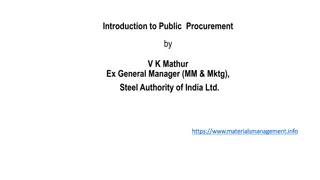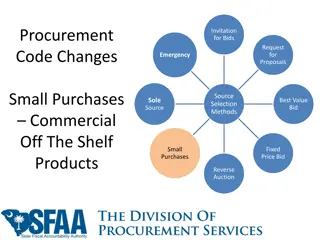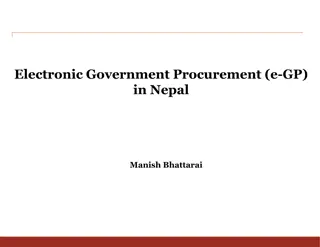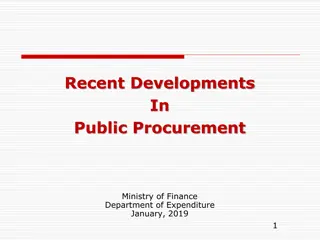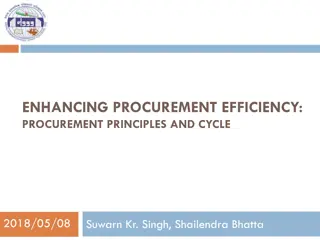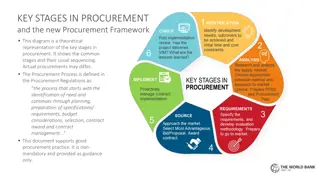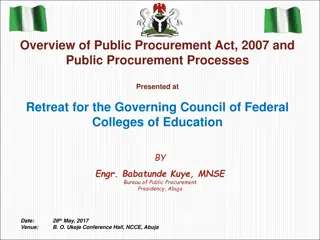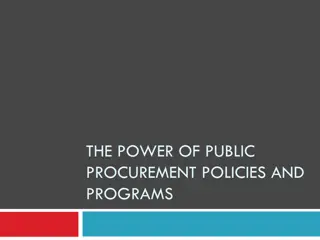Comparative Analysis of Competitive Procurement Mechanisms
This comparative analysis explores different competitive procurement mechanisms such as feed-in tariffs, bilateral deals, and auctions. It discusses their advantages, challenges, and applicability, covering aspects like volume control, price competition, market maturity, and institutional capacity. The analysis delves into how each mechanism addresses key issues in project realization and market dynamics, offering insights for policymakers and industry stakeholders seeking effective procurement strategies.
Download Presentation

Please find below an Image/Link to download the presentation.
The content on the website is provided AS IS for your information and personal use only. It may not be sold, licensed, or shared on other websites without obtaining consent from the author.If you encounter any issues during the download, it is possible that the publisher has removed the file from their server.
You are allowed to download the files provided on this website for personal or commercial use, subject to the condition that they are used lawfully. All files are the property of their respective owners.
The content on the website is provided AS IS for your information and personal use only. It may not be sold, licensed, or shared on other websites without obtaining consent from the author.
E N D
Presentation Transcript
Comparative Analysis of Competitive Procurement Mechanisms April 2019
Agenda Overview on difference administratively-set FITs, bilateral deals, auctions and their applicability The auction design process and design elements Simulation to understand the problem of the winner s curse and how it can be addressed Site-selected vs bidder-selected auctions How to set ceiling prices Technical requirements, financial guarantees and penalties to ensure project realization Conclusion
Feed-in tariffs provide high certainty for developers, but little volume control and price competition FEED-IN TARIFF + Secure revenue streams help less mature technologies and small project - Slow in reacting to market price changes, less competitive pressure - Low volume control + Not much market maturity, competition and RE market knowledge required o Experts to calculate and regularly update tariff, but procurement easier and flexible Administratively-set Feed-in tariff Government sets price (experts) Market determines volume (projects) Projects can be built until volume/budget cap is reached Policy goals Remuneration Realized projects Non realized projects Market maturity defined tariff Institutional capacity
Bilateral deals suitable for less mature markets, but are less scalable and transparent BILATERAL DEAL + Volume control and higher flexibility to tailor projects than auction + Competitive price building mechanism but lower than auction - Limited transparency - Risk of delayed realization due to negotiation stage o Competition needed but less than in auction - Difficult to scale if many bidders - Require capabilities for negotiations, but more flexible on timeline Bilateral deal Government sets volume Bidders offer price Negotiation determines price/changes in size Policy goals Remuneration Preferred bid Qualified, non-preferred bidder offered price Market maturity C B A Institutional capacity Defined volume Capacity (kW), production (kWh), budget, grid capacity
Auctions provide strong volume control, price pressure and scalability, but need competition AUCTIONS Auctions Government sets volume Market sets the price (clearing at price level where auction volume is met) + Volume control + Competitive price building high + Fast realization after award - Developers face risk of not being awarded and sunk cost + Easy to scale - Need high competition - RE producers need to know market to place bid - Require stronger institutional capabilities to build bidder interest Policy goals Remuneration Awarded bids Non awarded bids Price (pay- as bid or clearing) Market maturity Institutional capacity Defined volume Capacity (kW), production (kWh), budget, grid capacity
Focus on auctions: overview of auction design Market & regulatory analysis Market size Pre-developed project Market players Technology cost Project development & operation Existing regulations & incentives Target definition Auction design Imple- mentation ... Evaluation Institutional set-up What is auctioned Procurement procedure Conditions for participation Enforcement of obligation Rights for awarded projects Drafting of required documents Market building Procurement conduction RfQ RfP and awarding of bids Contracting Monitoring of realization Lessons learned Adjustment of procurement design Policy goals
Overview of different design elements and functions What is auctioned Technology type, technology size, auctioned item (kWh, KW, budget), multi vs. single-item auction Auction Procedure Static vs. dynamic auctions, price, selection criteria, pricing rule, number of rounds Conditions for participation Timing of the auction, technical requirements, financial bid bonds Enforcement of obligations Deadlines and penalties Rights for awarded projects Provisions against off-taker, political and currency risk Institutions Auction regulation, design, implementation, contract off-taker
Simulation the winners curse 1. Procurement auction for similar project 2. The bidder has difficulty in estimating his costs (symbolized by a can with cash). Each bidder estimates the amount of the cash in the can and notes it on a piece of paper. Cover the piece of paper. 3. Static sealed bid auction all bidders hand in their bids at the same time 4. Each bidder decides on a bid price and writes it on a piece of paper. 5. Announcement and evaluation of the results Based on Takon by Ehrhart, 2016
Introduction to the problem of the winners curse Definition Auction bid price is less than the actual value of the good, which will result in a loss for the auction winner Example Excessive yield or underestimated costs Impact on bidders Often bidders tend to estimate the costs relatively well If bidders are guided by their cost estimates in their bid strategy, the bidder who underestimates costs wins the auction Adequate bidding behavior Upward adjustment of the cost estimation in case of having a winning bid Adjustment of the bid where possible Based on Takon by Ehrhart, 2016
Site selection and preparation: benefits and challenges Government-site auction Bidder-site auction Auctioneer Auctioneer Procured volume (e.g. 100 MW) Bidder 1 Project site Selected & pre- developed 15 MW 25 MW Bidder 1 Bidder 2 Bidder 2 Bidder 3 Bidder 3 30 MW 30 MW Bidder 4 Bidder 4 Benefits Grid-compatible RE development. Lower risks & costs of project development if adequate quality. Challenges Higher admin. burden on government. Reduced role of bidders in finding optimal site. Risk of faulty site selection and preparation. Benefits Lower admin. burden on government. Site-specific risks mitigated through bidder- driven project development. Challenges Lower grid-compatible RE development in absence of locational signals. Higher risks & costs of project development if uncertainty about project costs and timeline.
Site selection and preparation: country examples Government-site auction Bidder-site auction Auctioneer Auctioneer Procured volume (e.g. 100 MW) Bidder 1 Project site Selected & pre- developed Bidder 1 Bidder 2 15 MW 25 MW Bidder 2 Bidder 3 Bidder 3 Bidder 4 30 MW 30 MW Bidder 4 Country examples: Country examples: Tanzania onshore wind and solar procurement South Africa (with easier project development in Renewable Energy Development Zones - REDZ) Mexico, Chile Senegal s Scaling Solar Dubai/Abu Dhabi (UAE) Morocco Denmark offshore wind
Ceiling prices control costs and generate market signals, but setting is a challenge Ceiling prices: relevance and calculation Relevance: Control over maximum costs Create price signal for market Price in Cent/kWh Ceiling price (e.g. LCOE-based) Disadvantage: Could signal lack of competition Ceiling difficult to set if little information Volume in MW Calculation: LCOE + margin to cover bid risk If applicable: previous feed-in tariff Cash-flow model analysis Adapt based on experience Defined volume Successful bids Unsuccessful bids 12
Most countries disclose ceiling prices Disclosing ceiling price Benefits: Helps prevent projects from being rejected in the auction. Gives bidders more planning security (sunk costs). Disadvantages: Bids close to ceiling price if low competition Price in Cent/kWh Ceiling price (e.g. LCOE-based) Country examples Volume in MW Undisclosed ceiling price South Africa, Peru (rounds 1-3) Disclosed ceiling price Brazil (combined with undisclosed auction volume), Mexico, India, Peru (round 4) Defined volume Successful bids Unsuccessful bids 13
Technical requirements and financial guarantees ensure quality of projects in auction Approval process Planning Construction Operation Early auction: RfQ stage RfP stage Late auction: RfQ stage RfP stage Project realization Country examples Ethiopia (government-sited, 100MW) Bid bond: $3/kW Completion bond: $15/kW Zambia (government-sited, 2x50 MW) Bid bond: $26/kW Completion bond: $300/kW ($15M per project) South Africa (bidder-sited) Bid bond: $8/kW Completion bond: $16/kW Conditions for participation + Technical: Selection of projects with sufficient progress in planning (ability to assess costs) + Financial: Bidders with intention to realize - - Technical: Sunk costs All: Prohibitive barrier for (some) bidders
Penalties enforce project realization Approval process Planning Construction Operation No/delayed realization Considerations Deadlines and penalties Penalties imposed in case project is delayed or fails to comply with the requirements stated in the PPA contract. + Incentive to realize due to penalties - - Risk for bidders increases Prohibitive barrier for (some) bidders Examples of penalties: Execution of financial guarantees if: Signing of PPA is delayed Project delays or cancellation Cancellation of the PPA Exclusion of bidder and/or project from future rounds. Country examples Zambia: termination of PPA if longstop deadline missed. South Africa: Reduction of PPA duration by 2 days/1 day of delay. Termination of PPA if deadline missed > 180 days.
Conclusion Auction needs to be tailored to local policy preferences, market maturity and institutional readiness Auctions provide most volume control and price reduction potential but market needs to have sufficient competition Site selection by government reduces bidder risk and eases grid integration but are more complex for the government Risk of underbidding and winners curse can be reduced through technical requirements and financial guarantees bidders can better estimate cost covering bids and have incentive to realize (also learning from winner s curse experiment)
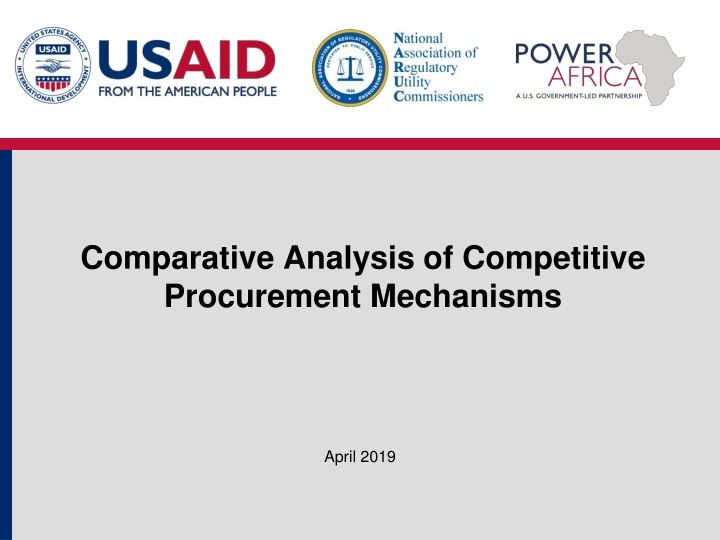


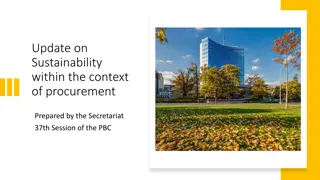
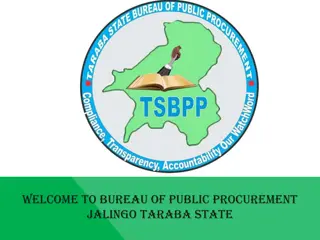
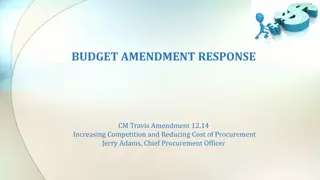
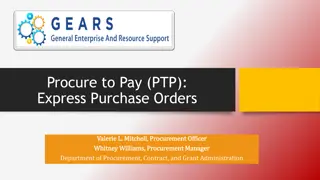
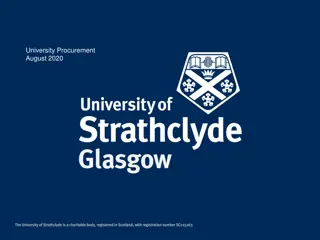
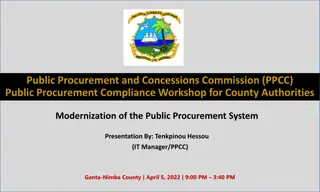
![Comprehensive Overview of Corruption Watch Submission on Public Procurement Bill [B18B-2023]](/thumb/138344/comprehensive-overview-of-corruption-watch-submission-on-public-procurement-bill-b18b-2023.jpg)
